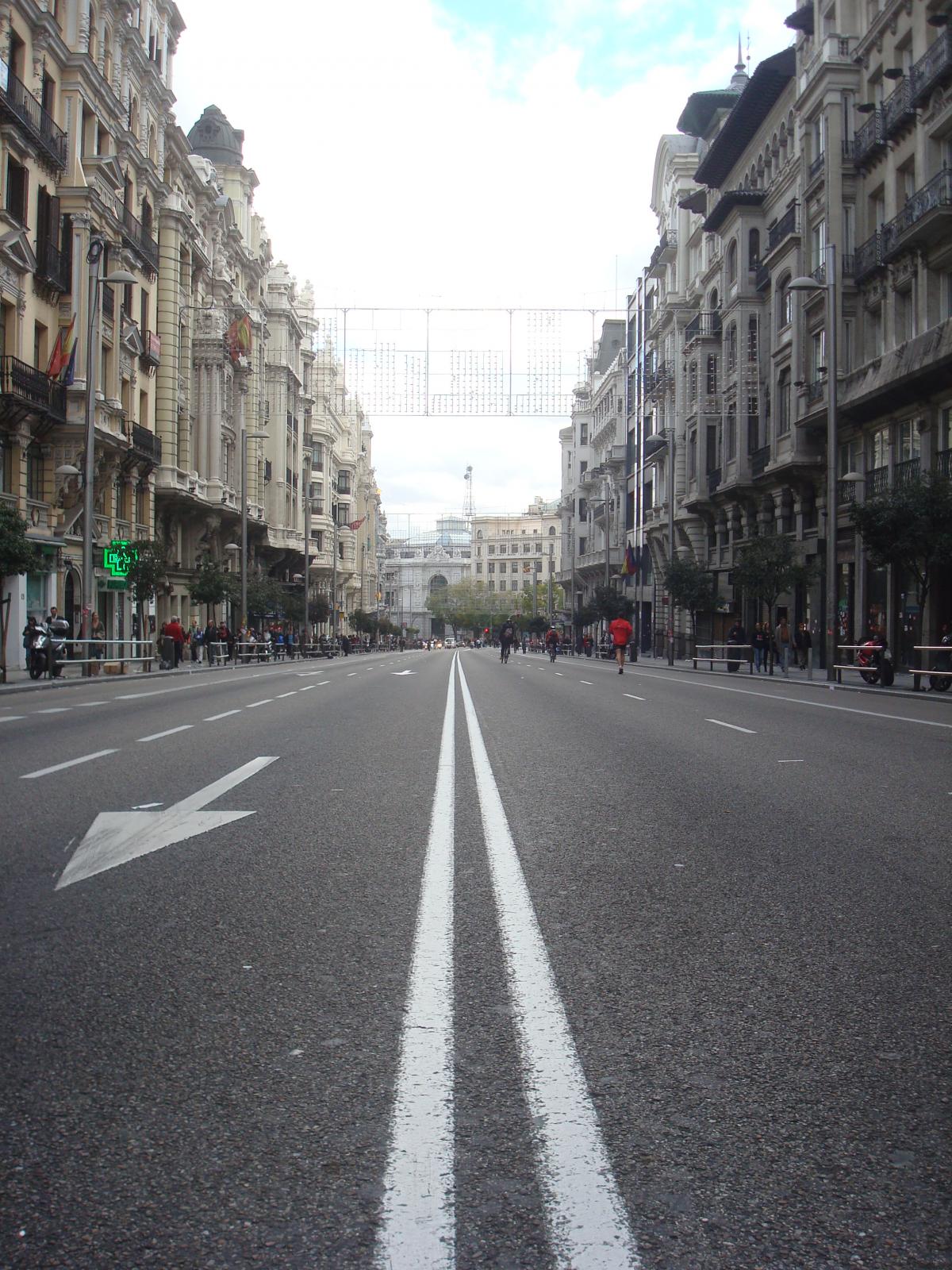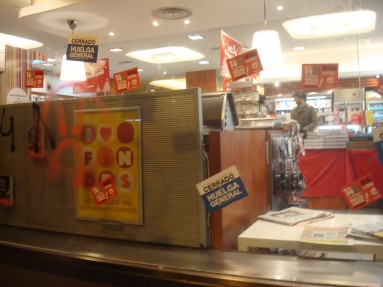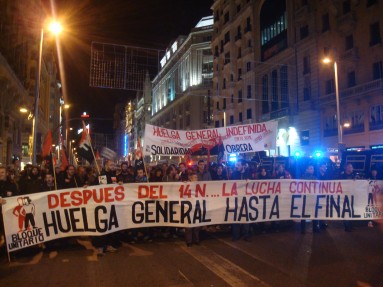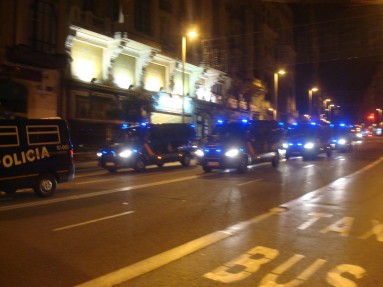Among the global superbrands radiating out from Madrid’s famous Puerta del Sol, the real growth industry is also Spanish history’s cornerstone commodity: gold. There are about 15-20 guys, none of them white, wearing sleeveless yellow fluorescent waistcoasts over their winter sweaters, plastered all over with the all-caps legend COMPRO ORO. I buy gold. Five hundred years after Spain subjugated large portions of the world and built its palaces on plundered gold and silver (by the 16th century, the equivalent of US $1.5 trillion’s worth), selling the family jewels has become a grim zeitgeist boom economy through bitter necessity.
50,000 Spanish homes were repossessed in the first half of 2012 alone – 400,000 since 2008 – while over 3 million properties lie empty. One month ago, the unemployment rate hit the staggering milestone-cum-millstone of 25 percent, while youth unemployment sits at an even more unbelievable 52 percent. These figures conceal an even bleaker truth of precarity, seasonal work, and short-termism, while Prime Minister Mariano Rajoy’s reviled labour reforms have made it easier to fire people, and removed most legal obligations to compensate your employees when you do. The IMF cheerily predicts Spain -- a country of fewer than 50 million -- will hit the 6 million unemployed mark next year.
The Compro Oro guys are of course not the architects, but the paid-by-commission stewards of the recession, shepherding the slow parade of debt down its unswerving path of misery. Divest yourself of all your worldly possessions, your heirlooms and indulgences – you too can achieve zen via neoliberal brutality.
All the zeitgeist jobs in crisis Madrid involve wearing yellow fluorescent jackets – whether you’re a goldwallah, a cop, or a security guard marshalling the bafflingly long lines for the relentless popular national lottery. At 1pm on a wet Thursday in November there were about 100 Madrileños of all ages and classes snaking around a corner of Calle Carmen waiting for their chance to buy a lottery ticket, three security guards keeping them in order.
“When you look at it from here, it doesn’t seem like there’s a crisis on,” observed one of the striking El País journalists I spoke to later that evening, gesturing at Madrid’s central shopping district, lights and logos glistening in the rain. But he said it wearily – he was above the cut-off age of 50, specifically earmarked by El País chief executive Juan Luis Cebrián as too old to be needed. A week before the high profile general strike, the newspaper’s employees were on strike over the “ere,” a kind of mass lay-off with next to no severance pay that had been enabled by the new labor reforms. El País will sack 139 journalists from a workforce of 450, a plan implemented by a chief executive who, they despaired, had once been a brave, campaigning editor, using his newspaper to fight the attempted military coup in 1981 with passion and integrity, and helping to establish a new pluralistic, democratic ethos in a febrile country still feeling its way into the light after 40 years of dictatorship.
Cebrián, who takes home 13m euros a year, told his striking journalists "we can't keep living so well."
Even a week before the strike, the streets of the Spanish capital were plastered with competing injunctions to join 14N from trade unions, anarchists, communists, and numerous anonymous possessors of red and black spray paint. By the eve of the strike, the shut-down was in process. The success of a general strike, like any strike, is measured by the level of participation: on the government’s side, there is a determination to show people are happy to keep working, that the infrastructure still functions, the trains run on time, and capital perseveres in the face of narcissistic union bosses. On the other side, it was clear from 8:30 the night before 14N that this general strike was to be as general as possible.
After a 4000-strong rally in Puerta del Sol called by the country’s largest trade union, the CC.OO, free bocadillos and coffees at their headquarters, and plenty of revolutionary milling about, at five-to-midnight, the largely grown-up crowd struck out into the city night to shut down the Spanish capital. Any businesses still open after midnight – which in Spain is quite a few –were harangued, implored, and plastered with stickers. One girl who must have been barely 16 was eagerly spray-painting banks and branches of Starbucks with the emoticon for a sadface, and the legend NO CONSUMISMO. I had been warned by friends to make sure I had ample food and cash before the general strike began, because the spirit of the day meant complete withdrawal from capital – “you don’t even buy a coffee or a bottle of water.” Even if you had wanted to withdraw money from an ATM on 14N, you would have found it impossible – part of the midnight flying picket involved superglueing, spray-painting, and stickering over the machines. A general strike is both a withdrawal and an intervention at the same time.
The Spanish congress building, for its part, had opted for withdrawal – behind not one but two layers of fences, and one layer of tooled-up riot police. This followed the ambitious plot on 25 September to Occupy Congress: not to storm the building, but to surround it, and prevent parliament from meeting until the MPs agreed to dissolve themselves. In contrast to the pluralistic span of the 8 million-strong indignados movement of May and June 2011, Occupy Congress was a hardcore of 5-10,000 leftists and unaffiliated angry young people. The 1400 riot cops stationed around the building were publicly told they could remove their badge numbers, and what had sounded like a creative, social media-organised attempt to blockade parliament turned into a night of dreadful violence. “The whole city the next day felt like it was in shock,” one leftist friend told me. “It really felt like something horrible had happened. Whatever your politics, no one wants a repeat of that.”
The only people who did were those with scores to settle from the September clashes. At 1pm on the day of the strike, I stepped out onto Gran Via to take the atmosphere and was immediately swept up in a substantial impromptu demo. The official marches were scheduled for the evening, but clearly a lot of people – old and young, red and anarchist, trade unionists and ninis (young people not studying or working) – just couldn’t wait. Gran Via sprawls the breadth of Madrid city centre, from the gaudy designer shops and theatres at one end to the intimidating formality and unapologetic grandeur of the Banco de Espana at the other, and around 5000 people were already marching down it: flyering, chanting, and plastering HUELGA GENERAL stickers over the driver’s side of bus windows. That is, the few that were still in operation.
The march arrived at Banco de Espana and stopped. Firecrackers and soon bottles flew through the air, plastic barricades intended for channeling the evening demo were strewn across Calle de Alcala – to my surprise, hardly any of those attacking the police lines had bothered to mask up at all, let alone absorb themselves into black bloc style anonymity. “Stand back,” one woman cautioned me, nervously gesturing towards a distant siren, “las lecheras are coming.”
The Spanish riot police vans are known as lecheras, milk vans, because when these grim thugs set about you with their batons they are said to be “giving you the milk” – a beating is a lecha. It’s quite a scene to see five of them hurtling down the avenida, sirens blaring, and in one seamless, performative movement, to see the side doors to slide open, and seven or eight cops batons raised unloading from each, spilling out and running, and young people turning and fleeing in every direction. The heady mixture of adrenaline, excitement, and panic is intensified by the somewhat unhelpful cries of “STAMPIDO!”
The reds, with their CC.OO flags and “health is not for sale” placards marched on away from these clashes. Some anarchists pleaded with them to come back and fight.
Two or three stampidos were enough for me, so I returned to safer ground to graze on the biscuits and cherry tomatoes bought way back in the capitalist past. The evening demo was due to begin in a couple of different locations – the anarchists, anarcho-syndicalists, and younger marchers would start at one point, the reds, grown-ups and trade unionists at another, and they would converge somewhere in the middle, on the massive, multi-lane art corridor, the Paseo del Prado. We chose the former, and sat on the grass verge at Plaza Legazpi in the south of Madrid, waiting for the crowds to amass, and the march to begin. Red and black flags fluttered past, bursts of my favourite new chant filled the air – “upwards, upwards, everyone to struggle / stick the labour reform up your arse”
Smart old men in criss-crossed Burberry rain jackets and brushed green corduroy trousers, unselfconsciously smoking pipes. Young activist women with lopsided fringes, a regiment of smiling anarcho-squatter Skrillexes. Children, adolescents, parents, grandparents – the people of Spain; hundreds and hundreds of thousands of them.
The march proceeded for hours, dragging its feet under its own sheer weight on the slow path into the center of the city – along the way there was singing, pogoing, and even dancing, under a sky filled with home made placards, and flags in red and black, or the historic purple, yellow, and red of the Spanish second republic. “We don’t want to be a colony of a German bank,” ran one of the chants. We reached the Paseo del Prado around 9 pm, and found the reds and CC.OO march, with a median age at least 20 years older, coming the other way. Far be it for me to say that the left struggles to pull together in the same direction.
Later that night, exhausted from spending nine hours alternately chirpily slow-marching en masse and sprinting away from riot police, I watched the second act of violent cat-and-mouse clashes in Plaza Neptuno via livestream. I was depressed by their futility in contrast to the holistic collective effort of the strike itself, the joyous zeal of the evening demonstration, or the imaginative intent behind Occupy Congress. At around 11:30 pm I walked over from Gran Via to Sol to meet the artist Molly Crabapple – also in town to cover the strike – for a nightcap, and had a head-spinning moment to rival the evening demo’s sensory overload.
There’s nothing quite like turning a quiet city corner and seeing 50 teenagers hurtling towards you like their lives depended on it. There had been (accurate) rumours of rubber bullets across town in Neptuno an hour or so before, and now the riot police were firing them at some mischievous unaffiliated teenagers. I say “mischievous” because they were all rather enjoying it; there was no dark-browed nihilism, nor moist-eyed, desperate rage – they would laugh, shout “Hey, you fuckers, you whores!” then sprint out of sight again. The reality of a rubber bullet, when it hits, is not nearly as light-hearted as these kids were. I saw about 10 discharged while hiding behind a newspaper kiosk as I tried to traverse the square.
By Friday, capital was back. Puerta del Sol was reclaimed from the angry, the dispossessed, and the riot cops by the Compro Oro guys, and the poor sods trying to earn a buck by dressing up as Spongebob, Chewbacca, and the Shrek version of Puss in Boots. Capital remains the zombie that just won’t go down: “no consumismo” lasted for a day, an island of resistance in a sea of deepening despair. Several million people across Spain (not to mention Portugal, Italy, Greece and beyond) marched, and almost 10 million withdrew their labor. 14N ended, but the pain continues.
Five days before the general strike, 53-year-old Amaia Egana became the second Spaniard in a matter of weeks to commit suicide on the day of the eviction from her home, throwing herself from a fourth-floor window as court officials came up the stairs to remove her. The uproar was so great that Mariano Rajoy announced a (non-retroactive) freeze on bank evictions in some extenuating circumstances. This does little to help the families of the deceased, or the people camping outside the same banks that repossessed their homes.
With the moment of resistance passed, the sceptics stretched out again. Over afternoon beers and tapas in a bar in the north of Madrid, Maripaz informed me coquettishly “You will not like my opinions of the strike, I think.” Tell me, tell me, I said. She concurred with some of the same non-partisan explanations of Spain in la crisis I’ve heard before – that the Spanish family is indirectly propping up the government, and preventing outright rebellion; married couples moving back in with their parents, grandparents providing childcare and even sharing their pension. “While you have a place to stay and something to eat,” she said, “it will slow you down from rebelling – maybe they will take a year or so before they take to the streets?” Everyone from King Juan Carlos I to full-time housing activists I have spoken to have mentioned this. So what’s the opinion I won’t like?
“Well, I think there is not really 25 percent unemployment.” There is a thriving black market, Maripaz explained (“the ‘b’ economy”): people working cash in hand for friends and contacts, small businesses employing people off the books, not declaring all their incomings and outgoings, because that little bit of tax will make all the difference to them sinking or swimming. “Look at Madrid,” she said – “does it look like a quarter of all working people are unemployed?” Gran Via and the shopping streets around it are humming with activity, undeniably – although perhaps that’s largely rich people and tourists? It’s impossible to measure how many people have simply slipped out of the system, and off the books. But this cuts both ways. As a young journalist called Cristina had told me the previous week, many of her friends who are officially employed are in such a dire state of precarity, that it seems absurd to count them as part of a happy, stable, prosperous 75 percent.
However you read the numbers, for some, la lucha will always continua. The day after the strike, an anarchist group called Solidaridad Obrera sought to answer the question “What do you do when the one day strike ends?” by calling a follow-up demo under the banner La Lucha Continua. As the 500 or so young men and women proceeded down Gran Via, watching alongside me was a man in his 60s called Eduardo. He was smartly dressed, and I assumed – wrongly – not a fan of the anarchists. “There are so many things wrong with this country,” he groaned. “I’m glad they’re still marching. They should never stop marching.”
There were scores – some count it at hundreds – of general strikes in 1930s Spain, in the revolutionary ferment throttled by Franco’s military coup, and the subsequent horrors of the civil war. A number of people I’ve met in Madrid have lamented that a single 24 hour general strike is not enough, that it’s just a fleeting act of protest, a moment of solidarity and exception, not an intervention that will bring the change that is needed. I turned to Eduardo again. So if they just keep marching, and keep on calling strikes, do you think that will bring Rajoy’s government down? He laughed. “I will die first.”




